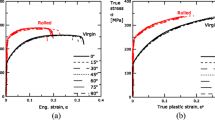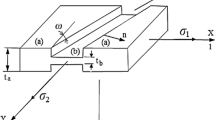Abstract
The finite element method is used to numerically simulate the topographic development in an aluminum sheet, AA6111, under pure bending. The measured electron backscatter diffraction data are directly incorporated into the finite element model, and the constitutive response at an integration point is described by the single crystal plasticity theory. The effects of strain-rate sensitivity, work hardening, and imposed initial surface roughness on surface roughening are studied. It is found that the grains in top surface layers of the sheet play a big role in controlling the outer surface roughness due to the strain gradient across sheet thickness in bending, while the grain size and texture of the surface layers have a direct impact on finishing surface qualities.



















Similar content being viewed by others
References
J. Datsko and C.T. Yang: Correlation of bendability of materials with their tensile properties”, 1960. Trans. ASME: J. Eng. Ind., 309-314.
D.J. Lloyd, D. Evans, C. Pelow, P. Nolan and M. Jain, 2002, Bending in aluminium alloys AA6111 and AA5754 using the cantilever bend test, Mater. Sci. Technol., 18, 621-628.
J. Sarkar, T. R. G Kutty, D. S. Wilkinson, J. D. Embury and D. J. Lloyd, 2004, Tensile properties and bendability of T4 treated AA6111 aluminum alloys, Mat. Sci. Eng. A369, 258-266.
Y. Shi, H. Jin, P.D. Wu, D.J. Lloyd and D. Embury, 2014, Failure analysis of fusion clad alloy system AA3003/AA6xxx sheet under bending”, Mater. Sci. Eng., A, 610(2014)263–272.
D.V. Wilson, W.T. Roberts and P.M.B. Rodrigues, 1981, “Effects of grain anisotropy on limit strains in biaxial stretching: Part II, sheets of cubic metals and alloys with well-developed preferred orientations”, Metall. Trans., 12A, 1603–1611.
D.V. Wilson, A.R. Mirshams and W.T. Roberts, 1983, “An experimental study of the effect of sheet thickness and grain size on limit-strains in biaxial stretching” Int. J. Mech. Sci., 25, 859-870.
R. Becker, 1998, “Effects of strain localization on surface roughening during sheet forming”, Acta metall., 46, 1385-1401.
A.J. Beaudoin, J.D. Bryant and D.A. Korzekwa, 1998, “Analysis of ridging in aluminum auto body sheet metal”, Metall. Mater. Trans., 29A, 2323-2332.
M.R. Stoudt and J.B. Hubbard, 2005, “Analysis of deformation-induced surface morphologies in steel sheet”, Acta Mater., 53, 4293-4304.
T. J. Turner and M. P. Miller, 2006, “Modeling the Influence of Material Structure on Deformation Induced Surface Roughening in AA7050 Thick”, J. Eng. Mater. Technol. 129, 367-379.
M.R. Stoudt, L.E. Levine, A., Creuziger and J.B., Hubbard, 2011, “The fundamental relationships between grain orientation, deformation induced surface roughness and strain localization in an aluminum alloy” Mater. Sci. Eng., A530, 107-116.
Q. Zhang, P.Z. Zhao, J.D. Liu, and Y.J.Feng: Light Met., 2015, M. Hyland, ed., pp. 333–37.
P.D. Wu, D.J. Lloyd, A. Bosland, J. Jin and S.R. MacEwen, 2003,”Analysis of roping in AA6111 automotive sheet”, Acta Mater., 51, 1945-1957.
P.D. Wu and D.J. Lloyd, 2004, “Analysis of surface roughening in AA6111 automotive sheet”, Acta Mater., 52, 1785–1798.
P.D. Wu, D.J. Lloyd, M. Jain, K.W. Neals and Y. Huang, 2007, “Effects of spatial grain orientation distribution and initial surface topography on sheet metal necking”, Int. J. Plasticity, 23, 1084-1104.
Y. Shi, P.D. Wu, D.J. Lloyd and J.D. Embury, 2015, “ Numerical Study of Surface Roughening in Blow-formed Aluminum Bottle with Crystal Plasticity”, Mater. Sci. Eng., A, 638, 97-105.
R.J. Asaro and A. Needleman, 1985, “Texture development and strain hardening in rate dependent polycrystals”, Acta metall., 33, 923-953.
P.D. Wu, K.W. Neale and E. Van der Giessen, 1996, “Simulation of the behavior of FCC polycrystals during reversed torsion”, Int. J. Plasticity, 12, 1199-1219.
ABAQUS User Manual, 2013, Version 6.13.
Acknowledgment
This work is supported by the Natural Sciences and Engineering Research Council of Canada (NSERC).
Author information
Authors and Affiliations
Corresponding author
Additional information
Manuscript submitted April 29, 2015.
Rights and permissions
About this article
Cite this article
Shi, Y., Zhao, P.Z., Jin, H. et al. Analysis of Surface Roughening in AA6111 Automotive Sheet Under Pure Bending. Metall Mater Trans A 47, 949–960 (2016). https://doi.org/10.1007/s11661-015-3260-2
Published:
Issue Date:
DOI: https://doi.org/10.1007/s11661-015-3260-2




